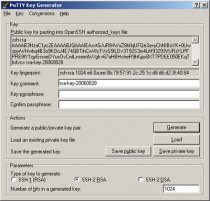Puttygen public key extension
Windows SSH Key Generation
 The PuTTYgen program is used to generate a public/private
key pair under Windows and will generate a 1024-bit RSA key by default.
PuTTY programs are available from Simon Tatham.
The PuTTYgen program is used to generate a public/private
key pair under Windows and will generate a 1024-bit RSA key by default.
PuTTY programs are available from Simon Tatham.Generate A New Key Pair
- On the desktop machine or laptop that you will be using to login to
the RACF, from the PuTTY submenu in the
Start menu, open the PuTTYgen
program.
- Using the defaults, click the Generate button, and then move your mouse around in the space above the Generate button.
- When the key pair generation has completed, you will see a result
similar to the following image, with both the Save public
key and Save private key buttons now active.
If desired, you can change the value of the Key
comment: field.
- Enter a passphrase in both the Key passphrase and
Confirm passphrase fields.
- To save your new keys, click the Save public key
and Save private key buttons.
The default save location for both files is the folder just above your My Documents folder, and your private key will have the file extension .ppk.
Keep this window open so that you can copy and paste the key fingerprint later in the procedure. - To upload your key file,
browse to:
https://web.racf.bnl.gov/Facility/SshKeys/UploadSshKey.php
In order to view the form, you will be prompted for your Kerberos user name and password. - Click the Browse button, and in the dialog box,
navigate to your ~/.ssh directory (or the directory in which
your public key file is stored).
The dialog box will likely open in the default location for the key files. If not, you will need to navigate to the appropriate folder. Once in the correct folder, select the public key file, and click
Open.
Once in the correct folder, select the public key file, and click
Open. - Copy and paste your public key fingerprint from the Key fingerprint: field of the PuTTY Key Generator into the second box in the form, or type it manually into the dialog box. The key is comprised of 16 2-digit hexadecimal numbers separated by colons (:).
- To upload your key file, click the Send File button.
- You can now login to one of the gateway machines using SSH keys. You will be prompted for the passphrase for you private key during the login process. The passphrase will not leave your local machine.
- To obtain your Kerberos and AFS credentials, once you have logged into a gateway machine, enter the command: kinit -5 -4 -l 7d where the third argument is a lower case L, exactly as specified.




